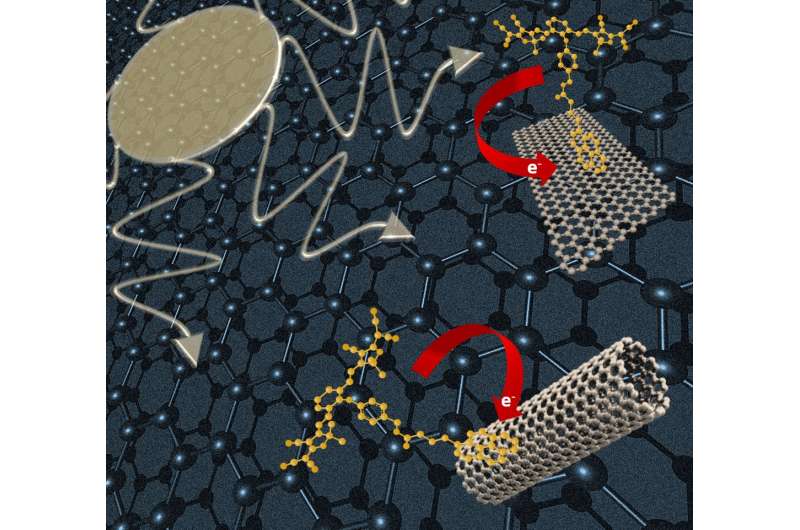Scientists investigating properties of hybrid systems consisting of carbon nanostructures and a dye

Researchers around the world are looking at how they can manipulate the properties of carbon nanostructures to customise them for specific purposes; the idea is to make the promising mini-format materials commercially viable. A team at Friedrich-Alexander-Universität Erlangen-Nürnberg (FAU) has now managed to selectively influence the properties of hybrid systems consisting of carbon nanostructures and a dye.
Carbon nanostructures offer a lot of potential. Both two-dimensional graphene and one-dimensional carbon nanotubes have unique properties that make them interesting when it comes to possible industrial applications. Carbon nanostructures could be used in new kinds of solar power systems in combination with a dye that absorbs light at wavelengths in the near infra-red range, for instance. Thus, unlike conventional solar power generators, these new systems would utilise not only radiation with wavelengths in the visible range but also in the near infra-red region. This is, however, only one of a number of potential areas of application—the nanostructures could also be used in sensor technology, in electrodes for touch screens and in field-effect transistors.
But scientists first need to understand the mechanisms occurring within the hybrid systems consisting of carbon nanostructures and a dye before they can generate them in a form in which they can be employed in actual applications. A research team at FAU's Chair of Physical Chemistry I is now a step closer towards achieving this goal.
Alexandra Roth and Christoph Schierl of the team headed by Professor Guldi created hybrid systems consisting of graphene and a dye and carbon nanotubes and a dye in the laboratory—namely in the liquid phase, a technique that keeps costs low and ensures the materials are easier to handle. Of particular advantage to their research was the fact that they managed to generate and analyse both hybrid systems at the same time. This approach made it possible to assess and evaluate the data for both systems and thus compare them.
Changes in the photovoltaic properties indicated that the materials had indeed formed hybrid systems. The researchers were able to demonstrate that, by means of interactions in the basic state, the dye had a specific effect on the electronic properties of the carbon nanostructures. This successful manipulation of the properties of hybrid systems has brought the researchers a step closer towards gaining the ability to effectively employ these carbon nanostructures in real applications.
Additionally, they also found that when light was used to stimulate the systems, each dye molecule transferred an electron to the carbon structures that was then transferred back to the dye after a few nanoseconds—an essential requirement if the systems are to be employed in dye-sensitised solar cells.
More information: Alexandra Roth et al, Low-Dimensional Carbon Allotropes: Ground- and Excited-State Charge Transfer with NIR-Absorbing Heptamethine Cyanine, Chem (2017). DOI: 10.1016/j.chempr.2017.05.003
Provided by University of Erlangen-Nuremberg





















